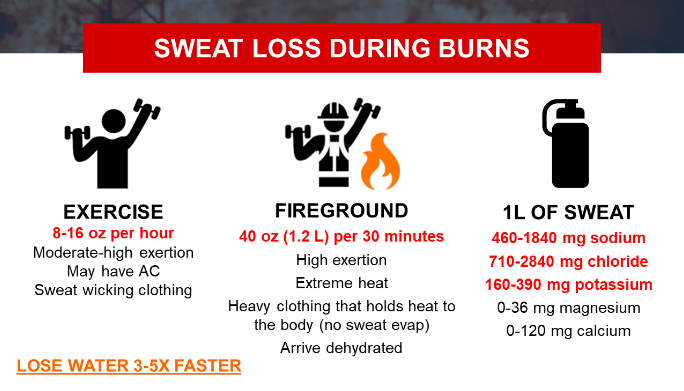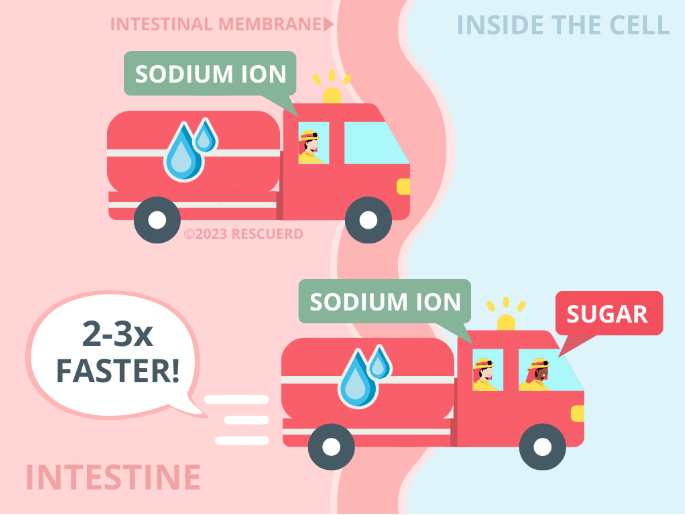Mango Pineapple Smoothie Escape the daily grind with this tropical...
Read MoreWith the weather heating up, staying hydrated is more important than ever. Electrolytes are a key part of staying hydrated on shift, but with so many products out there, which one do you choose?
Electrolytes are minerals that carry electrical charge; including sodium, chloride, potassium, and magnesium. These particles are essential for fluid balance, muscle contraction, and heart function. A drastic change in electrolyte levels can significantly impact performance and body function. With sweat losses on the fireground clocking in at up to 40 oz per 30 minutes, this can happen quickly. Making replacement essential to continue activity and assist with rehydration.
So, how do electrolyte products assist with rehydration? Electrolytes control the flow of water into cells. The ion channels found on cell membranes regulate the flow of electrolytes into cells. Water follows, flowing to the side of the membrane with more electrolytes (aka osmosis). Therefore, electrolytes are essential for rehydrating and holding onto fluid.

There are many hydration products on the market, and it’s easy to just buy the one that is on sale at Costco that month (I’ve been there). However, some products work better in different scenarios. Since shifts can range from sitting around to running into a burning building, it may help to trial a few options in different scenarios to see what works for you!
When to Use: Hot, active shifts. Fire-related calls. Workouts in the heat lasting more than one hour.
To optimize rehydration fast, opt for an Oral Rehydration Solution like DripDrop, Liquid I.V., or Pedialyte Sport. These products have half the sugar and double the sodium of sports drinks and are 20% more effective than sports drinks. ORS products were developed for the cholera epidemic and can rehydrate and IV fluids for mild to moderate dehydration.
Opt for the original products WITH sugar (not sugar-free). A little bit of glucose (10-15 g) can speed up rehydration by providing access to the sodium-glucose cotransporter on the cell. Glucose is co-transported with sodium in the intestinal tract, and water is absorbed through the osmotic gradient created by sodium and glucose. Note that you can absorb sodium and water without glucose; it will just take more time. For a dehydrated firefighter with more work to do, speed is essential. Keep a few packs in a go bag or on your assigned unit just in case.

When to Use: You’re on keto or are a super salty sweater.
As mentioned, sugar-free electrolyte products help rehydrate, though they may not be as fast as those containing a bit of sugar. LMNT or FireSalt falls into this category and contains even more sodium than DripDrop or Liquid I.V. (1000mg vs. 600mg). For very salty sweaters, this can be a lifesaver. Salty sweaters often have a white rim around their duty shirt, hat, or hood. Try a Gatorade Sweat Patch to see where your sweat losses clock in if you are a numbers person. You may need to tape it to your forearm if you are really sweaty.
When to Use: Workouts in the heat lasting longer than one hour or this is what is available at fire-related calls.
Standard sports drinks like Gatorade or Powerade may not have enough sodium (190 mg per 16 oz) to replace fireground losses, which is why many departments are switching to ORS products like DripDrop or Liquid I.V. However, sport drink also tastes less salty than many electrolyte options, which is important for rehydrating as well. These may be better for non-fire-related drills or workouts lasting an hour or more. Basically, trainings that are active but not super sweaty.
When to Use: Cool and slow shifts. You’re bored with plain water.
As mentioned above, sodium is one of the main electrolytes lost in sweat in large amounts and is essential to assisting fluid into the cells. Often, these lower sodium options are coconut-water-based, like Prime or Body Armour. The potassium content is great, but both clock in at 40 mg sodium per 16 oz. These could work to mix up your hydration options on a cool, slower day. The sodium is too low for hotter, more active shifts. If you prefer these products, consider adding a salt packet or drinking with a salty snack like pretzels.
As mentioned, having options based on the shift might not hurt. Plus, it is important to trial a few different products to see what works for you. You know the product worked if you do not get that tired, groggy, drained feeling after a hot call or drill. If you want to limit it to one, go with an ORS packet like Liquid I.V., DripDrop, or Pedialyte Sport due to the rehydration speed and portability.
**Disclaimer – Palm Beach County Fire and Rescue or Megan Lautz do not endorse products mentioned in this article. The provided information is intended for the first responder to make the best-educated purchase if interested in electrolyte products.
Megan is a Registered Dietitian and coach who specializes in firefighter nutrition. Megan’s mission is to help firefighters perform better, recover faster, and enjoy long, healthy retirements. Megan is the owner of RescueRD LLC, which provides nutrition seminars and coaching for tactical athletes across the country. Check out @Rescue.RD on Facebook and Instagram.
Mango Pineapple Smoothie Escape the daily grind with this tropical...
Read MoreLemon Pepper Chicken Bowls Enjoy grilled or oven-baked chicken with...
Read MoreExercise is not without its risks and this or any other exercise program many result in injury. As with any exercise program, if at any point during your workout you begin to feel faint, dizzy or have physical discomfort, you should stop immediately and consult a medical professional. You should rely on your own review, inquiry and assessment as to the accuracy of any information made available within this program or via this web site.